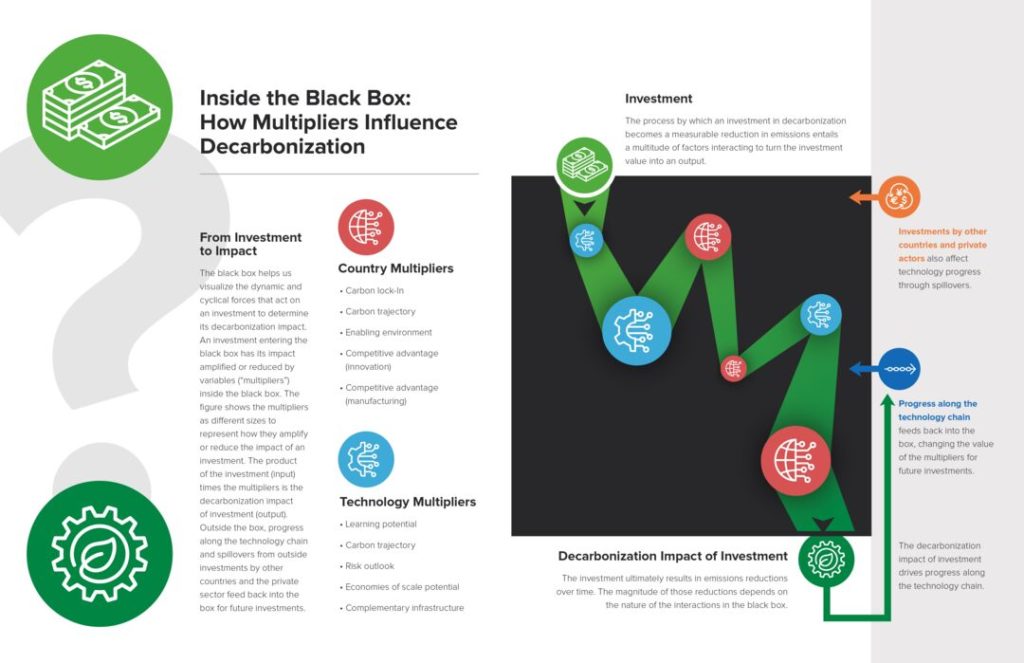
Spending Inside the Box
When we think about measures to address climate change, we often think of solar panels or wind farms. While it is true that we need to transition to renewable energy, investment in clean energy generation is only one piece of an economy-wide climate puzzle. To fully decarbonize, we need to obtain our essential goods and services in all sectors—power, heating and cooling, transportation, manufacturing—from low-carbon sources instead of fossil fuels.
This massive transition hinges on the availability of market-ready, clean alternatives for these services, plus the enabling conditions to adopt them worldwide. While solutions like renewable energy have already cleared these thresholds, many other clean technologies are still under development, and some simply don’t exist yet. The technological revolutions of the past took decades, but to realize economy-wide decarbonization in time, we need to make progress more broadly and more quickly than ever before.
Today’s technological revolution is achievable if we fund it right. We can undertake the clean transition faster and at lower global cost based on how and when we invest—if we have the vision to change our approach. Public finance, once called the “golden key” to unlocking climate action, can guide the changes we desperately need, but far too little has been done to optimize its potential for decarbonization.
For an individual policymaker, there are endless combinations of investments that could contribute to progress. In theory, more investment in decarbonization should yield more technological progress. In reality, some investments yield outsized emissions reductions per dollar while others fall flat. This disconnect is why increasing amounts of climate finance haven’t produced markedly greater emissions reductions. But why does that disconnect exist at all?
Inside the Black Box of Decarbonization
Picture a black box. Something goes into the box and something quite different comes out. What transformation is happening inside, out of sight? In the recent report Recasting the Golden Key: How Public Finance Can Unlock a Critical Decade of Climate Action, RMI and ClimateWorks Foundation use the concept of the black box to show the complexity at work in any investment in decarbonization. The black box provides evidence that governments need to take a more integrated and holistic approach to their expenditures for decarbonization.
When an actor (in this case, a government) invests in a technology, a multitude of factors interact in incredibly complex ways to determine the investment’s success for driving outcomes (in this case, decarbonization). Investment enters the black box, and emissions reductions come out. But what quantity of emissions reductions? And when? And what factors determine those answers?
Inside the black box, the investment interacts with “multipliers” that can increase or reduce the investment’s ultimate decarbonization impact. These multipliers reflect characteristics of the country making the investment (e.g., where the country has a competitive advantage, how strongly it’s locked in to emitting infrastructure, its policy and regulatory environment) and characteristics of the technology (e.g., its stage of development and how quickly its price will fall). Not only do all these variables interact in real time as a technology develops, but they’re also affected by private sector investments and the actions of other countries.
Rethinking Convention
Given the complex and dynamic nature of the black box, it would be incredibly difficult to pinpoint the value of each variable within. We don’t think it would be fruitful to search for the uber-model that will solve for the exact outcome of each possible investment. Instead, the breadth of factors involved in funding technology development and deployment—and the inherent difficulty in quantifying the magnitude or direction of these factors with any precision—point to the need for a new approach to choosing decarbonization investments. To consider the contents of the black box as a whole would require changing the structures and processes that underpin the way governments make expenditure decisions.
Currently, most expenditure processes are set up to support individual goals and policies, so responsibility for expenditures related to decarbonization (or locking in fossil fuels) is often spread across the government apparatus. Different policymakers have purview over spending for the various stages of technology development and deployment, manufacturing, public procurement, technology subsidies, fossil fuel subsidies, import tariffs, and foreign assistance, among many other things. Yet despite the obvious synergies—and contradictions—in these areas of spending, they are remarkably siloed.
When policymakers secure and spend their respective budget allocations in isolation, it is nearly impossible to know if they have made decisions that support or are supported by their colleagues’ expenditures. In other words, siloing means each policymaker can only see a few of the variables in the black box.
A Holistic Approach to Unlock Decarbonization
We propose that policymakers make changes to support a holistic approach, bringing their perspectives together to build a fuller picture of the black box. Better coordination across relevant government agencies can improve understanding of the relative potential of different investments. At the international level, coordination between countries can help identify synergies, areas for collaboration, areas of replication, complementary competitive advantages, and potential competition. In Recasting the Golden Key, we explore ways forward to develop a more holistic spending approach.
Public finance has not fulfilled its potential as a golden key, but we have the power to recast that key by changing how we spend. We urge governments to reimagine their role in this critical decade. Expenditures made without the big picture perspective will not set the global economy on a low-carbon trajectory in time. However, a holistic approach could unlock decarbonization by targeting opportunities across the economy to harness the value of individual investments within and between countries. This kind of domestic and international cooperation isn’t easy, but the window for easy fixes has closed.
Download Recasting the Golden Key: How Public Finance Can Unlock a Critical Decade of Climate Action
Users can explore the variables in the black box for themselves using our black box simulation.


